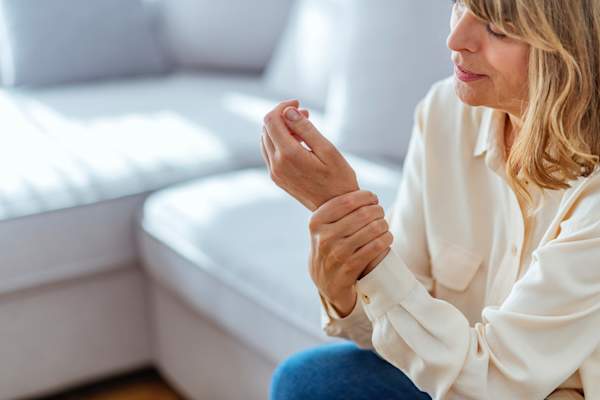Can Therapy Ease Your Joint Pain?


The concept of seeing a therapist for your osteoarthritis (OA) probably isn’t that shocking—if it’s a physical or occupational therapist, that is. But what about talking to a psychotherapist? Sounds weird, right? Research shows that a type of talk therapy called cognitive behavioral therapy (CBT) can actually improve your arthritis pain. And the latest guidelines from the American College of Rheumatology (ACR) and the Arthritis Foundation recommend you add CBT to your arthritis-management arsenal. Here’s more on how it works.

There's Evidence That CBT May Ease Chronic Pain
While there’s not yet a ton of research on CBT and OA specifically, there’s plenty that supports the use of CBT for chronic pain, which means it’s likely to help people with OA. One 2017 systematic review found that CBT was effective at helping people with fibromyalgia better cope with their pain. CBT is a short-term, highly effective therapy, says psychologist Randye J. Semple, Ph.D,, an associate professor in the department of psychiatry and behavioral sciences at the University of Southern California. And it has been shown to improve pain, health-related quality of life, negative mood, fatigue, functional capacity, and disability.

CBT Is About Retraining Your Brain
So how exactly doesCBTwork? It’s actually pretty simple, Dr. Semple says: “If you look at three corners of a triangle, one corner is our thoughts, one corner is our emotions, and one corner is our behaviors—and these all influence each other. CBT is based on the idea that if what we’re thinking isn’t accurate or isn’t helpful in some way, if we change those thoughts, then we’ll change the moods and behaviors.” That’s the cognitive part of CBT—reshaping your thoughts, which can impact your feelings and actions.

CBT Can Make Your Pain Feel Less … Painful
OA is the breakdown of joint tissue, and at a certain point, there’s only so many medications or procedures your doctor can prescribe to help with the pain in your knees, hands and other joints. But how we respond to the pain is something that is within our control, says Dr. Semple.
To address this in CBT, your therapist may help you work toward restructuring your thoughts about your pain to help you stop feeling helpless and catastrophizing about your symptoms and replacing those thoughts with healthier, more rational thoughts to help you cope.

You'll Learn Practical Tips to Minimize Pain
Your therapist will likely teach you habits to cope with your pain. And there will be things to try at home, so, homework! This may include things like trying out activity-rest cycling. “The best thing you can do for yourself [when you have OA] is movement,” says Sonja Rosen, M.D., chief of geriatric medicine at Cedars-Sinai Medical Center in Los Angeles.Physical activity can lead to increased mobility and pain relief, she says. But learning to pace yourself and schedule in periods of rest with your activity is an important skill you may learn in CBT to help reduce your pain.

CBT Can Help You Distract and Relax
Other coping skills you may learn, the 2017 study says, include distraction techniques—things like imagery and relaxation exercises, including muscle relaxation. Part of the healthier coping mechanisms you may learn in CBT also involve learning to identify early triggers for your pain and adjusting your behavior accordingly—perhaps by using some of these distraction techniques.
“If there are behavioral changes that can be made, then the behavioral component of CBT involves starting small, developing skills, trying out new behaviors, and then building up more and more—that’s often the weekly homework with CBT,” says Dr. Semple.

Mindfulness May Play a Role
Some CBT therapists incorporate mindfulness into their treatment, which may be helpful for people living with OA looking to better manage their pain. Mindfulness is the practice of becoming aware of our thoughts, feelings, bodies, and environment in an accepting and nonjudgmental manner, according to Jon Kabat-Zinn, Ph.D., the founder of an 8-week structured program calledMindfulness-based Stress Reduction. Meditation and yoga are common types of mindfulness, for example, but it can also involve simple activities like breathing exercises. Practicing mindfulness—and nonjudgmentally becoming aware of the pain—can help reduce the subjective feelings of that pain, Dr. Semple says.

Finding a CBT-Trained Therapist Is Simple
Not all therapists are trained in CBT, so it’s important to do your homework before making an appointment with just anyone. Here are some resources:
- The Association of Behavioral and Cognitive Therapies
- Psychology Today
- Your insurance company:大多数保险公司都允许您搜索通过their website for clinicians that are covered by your plan. You can always call or email and simply ask about their experience with CBT, Dr. Semple says.

CBT Works Pretty Quickly
CBT is often shorter-term than other types of talk therapy models, says Dr. Semple.
“I generally start most of my patients with a 10-session agreement,” says Dr. Semple. “Let’s work together for 10 sessions toward a specific goal, and we’ll check in with each other at the fifth session, make sure we’re moving in the direction that we want to be moving in.”
Remember—most therapists appreciate feedback! Let them know what is or isn’t working for you—that way, you’ll be able to work as a team to get you feeling better faster.

The Mind Is a Powerful Thing
If you’re finding your OA difficult to manage—whether on a physical or mental level—CBT may be worth a try. While the idea of starting to see a therapist may feel intimidating, know that there’s plenty of evidence to support CBT’s effectiveness in helping people with chronic pain.
“CBT is very useful, very powerful, and very effective. And it works relatively quickly,” says Dr. Semple. “It’s a goal-oriented, collaborative model of therapy. We say that the primary goal of CBT is to make the patient their own therapist.”
- 2017 Study on Fibromyalgia Pain and CBT:European Journal of Pain. (2017). "Efficacy, acceptability and safety of cognitive behavioural therapies in fibromyalgia syndrome: a systematic review and meta-analysis of randomized controlled trials."ncbi.nlm.nih.gov/pubmed/28984402
- Latest ACR/AF Guidelines on OA Management:American College of Rheumatology. (2020). "2019 American College of Rheumatology/Arthritis Foundation Guidelines for the Management of Osteoarthritis of the Hand, Hip, and Knee."rheumatology.org/Portals/0/Files/Osteoarthritis-Guideline-Early-View-2019.pdf
- Mindfulness Information:Greater Good Magazine. UC Berkeley. (n.d.). "What Is Mindfulness?"greatergood.berkeley.edu/topic/mindfulness/definition
- News Release on ACR/AF Guidelines:American College of Rheumatology. (2020). "American College of Rheumatology/Arthritis Foundation Release Updated Treatment Guideline for Osteoarthritis."globenewswire.com/news-release/2020/01/07/1967510/0/en/American-College-of-Rheumatology-Arthritis-Foundation-Release-Updated-Treatment-Guideline-for-Osteoarthritis.html
- CBT and OA Pain Study:The Journal of Physical Therapy Science. (2017). “Cognitive behavioural therapy and pain coping skills training for osteoarthritis knee pain management: a systematic review.”ncbi.nlm.nih.gov/pmc/articles/PMC5890238/
